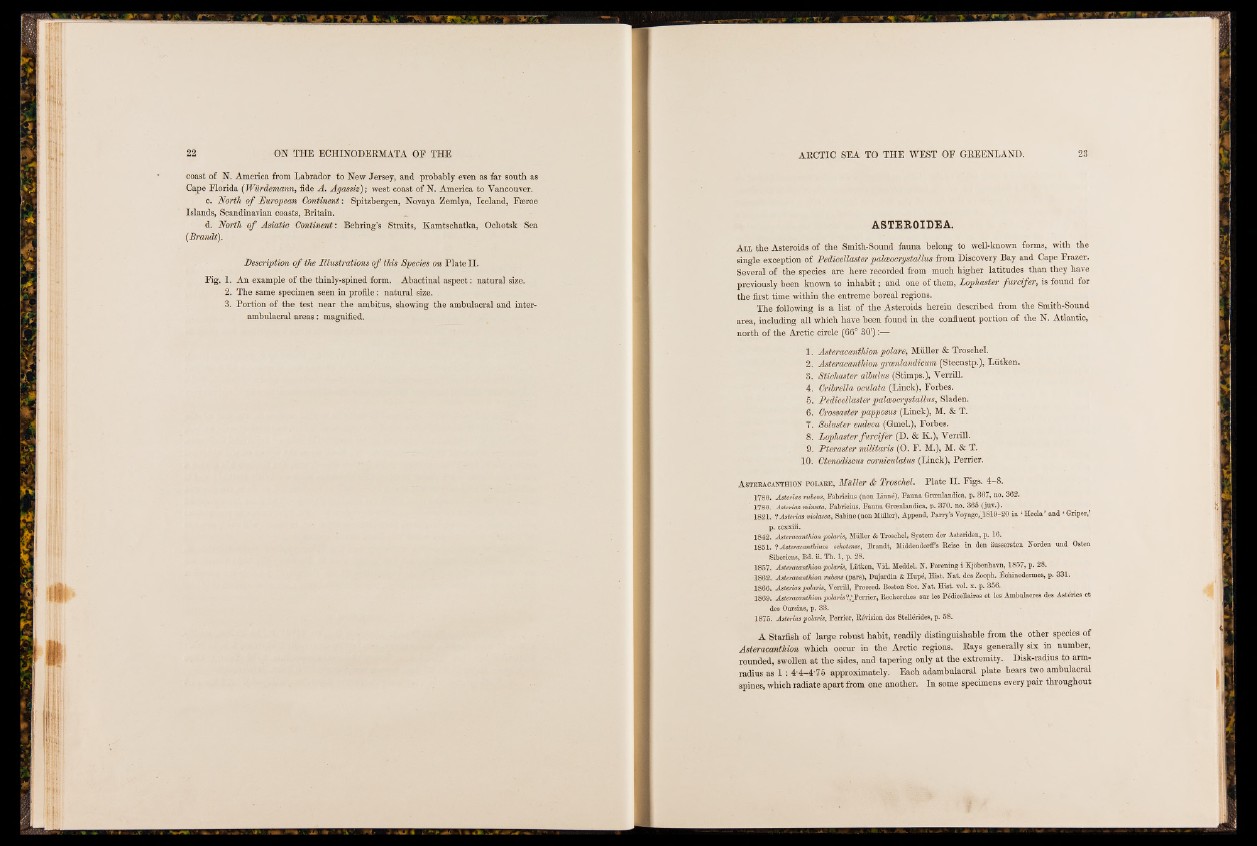
coast of N. America from Labrador to New Jersey, and probably even as far south as
Cape Florida (Wurdevnann, fide A. Agassiz); west coast of N. America to Vancouver.
c. North o f European Continent: Spitzbergen, No.vaya Zemlya, Iceland, Faeroe
Islands, Scandinavian coasts, Britain.
d. North o f Asiatic Continent: Behring’s Straits, Kamtschatka, Ochotsk Sea
{Brandt).
Description o f the Illustrations o f this Species on Plate II.
Fig. 1. An example of the thinly-spined form. Abactinal aspect: natural size.
2. The same specimen seen in profile: natural size.
3. Portion of the test near the ambitus, showing the ambulacral and interambulacral
areas: magnified.
ASTEEOIDEA.
At.t. the Asteroids of the Smith-Sound fauna belong to well-known forms, with the
single exception of Pedicellaster palceocrystallus from Discovery Bay and Cape Frazer.
Several of the species are here recorded from much higher latitudes than they have
previously been known to inhabit ; and one of them, Lophaster furcifer, is found for
the first time within the entreme boreal regions.
The following is a list of the Asteroids herein described from the Smith-Sound
area, including all which have been found in the confluent portion of the N. Atlantic,
north of the Arctic circle (66° 30') :—
1. Asteracanthion polare, Müller & Troschel.
2. Asteracanthion groenlandicum (Steenstp.), Lütken.
3. Stichaster albulus (Stimps.), Verrill.
4. Cnbrella oculata (Linck), Forbes.
5. Pedicellaster palceocrystallus, Sladen.
6. Crossaster papposus (Linck), M. & T.
7. Solaster endeca (Gmel.), Forbes. .
8. Lophaster furcifer (D. & K.), Verrill.
9. Pteraster militaris (O. F. M.), M. & T.
10. Ctenodiscus comiculatus (Linck), Perrier.
Asteracanthion polare, Müller & Troschel. Plate II. Figs. 4-8.
1780. Asterias nibens, Fabricius (non Linné), Fauna Groenlandica, p. 367, no. 362.
1780. Asterias minuta, Fabricius, Fauna Groenlandica, p. 370. no. 365 (juv.).
1821. 2 Asterias violacea, Sabine (non Midler), Append. Parry’s Yoyage,JL819 -2 0 in ‘ Heda and ‘ Griper,
p. ccxsiii.
1842. Asteracanthion polaris, Müller & Troschel, System der Asteriden, p. 16.
1851. ? Asteracanthium ochotense, Brandt, MiddendorfFs Reise in den äussersten Norden und Osten
Sibériens, Bd. ii. Th. 1, p. 28.
1857. Asteracanthion polaris, Lütken, Yid. Meddel. N. Forening i Kjobenhavn, 1857, p. 28.
1862. Asteracanthion miens (pars), Dujardin & Hupé, Hist. Nat. des Zooph. Échinodermes, p. 331.
1866. Asimas polaris, Yerrill, Proceed. Boston Soc. Nat. Hist. vol. x. p. 356.
1869. Asteracanthion polaris ?,^Perrier, Recherches sur les Pédioellaires et les Ambulacres des Astéries et
des Oursins, p. 33.
1875. Asterias polaris, Perrier, Révision des Stellérides, p. 58.
A Starfish of large robust habit, readily distinguishable from the other species of
Asteracanthion which occur in the Arctic regions. Rays generally six in number,
rounded, swollen at the sides, and tapering only at the extremity.. Disk-radius to arm-
radius, as 1 : 4-4-4-75 approximately. Each adambulacral plate bears two ambulacral
spines, which radiate apart from one another. In some specimens every pair throughout